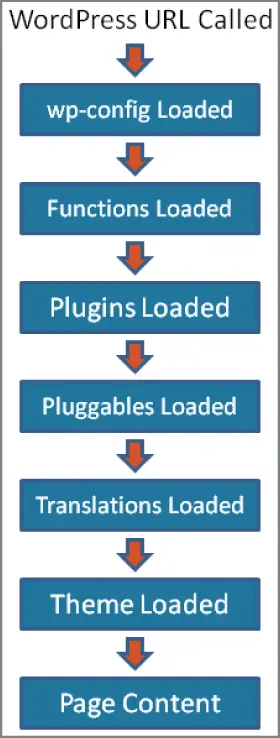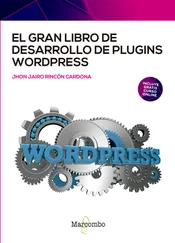1 ...6 7 8 10 11 12 ...18 WARNING Pluggable functions are no longer being added to WordPress Core. Newer functions utilize hooks for overriding their functionality.
You can use some predefined functions during specific plugin tasks, such as when a plugin is activated or deactivated and even when a plugin is uninstalled. Chapter 2, “Plugin Framework,” covers these functions in detail.
Plugins are loaded early in the process when a WordPress‐powered web page is called. Figure 1‐1shows a high‐level diagram of the standard loading process when loading a page in WordPress.

FIGURE 1‐1 : Loading a page in WordPress
The flow changes slightly when loading an admin page. The differences are minor and primarily concern what theme is loaded: admin theme versus your website theme.
When researching available plugins, you need to know where to find WordPress plugins. You can download plugins from many places on the Internet, but this isn't always a good idea.
WARNING As with any software, downloading plugins from an untrusted source could lead to malware‐injected and compromised plugin files. It's best to download plugins only from trusted websites and official sources such as the official Plugin Directory.
Official Plugin Directory
The first place to start when researching available WordPress plugins is the official Plugin Directory at WordPress.org. The Plugin Directory is located at https://wordpress.org/plugins. With more than 55,000 plugins available and millions of plugin downloads, it's easy to see the vital role plugins play in every WordPress website. All plugins available in the Plugin Directory are 100 percent GPL and free to use for personal or commercial use.
Take a look at some of the more popular WordPress plugins available to get a sense of their diversity:
Yoast SEO: Advanced search engine optimization functionality for WordPress. Features include custom metadata for all content, canonical URLs, custom post type support, XML sitemaps, and more! https://wordpress.org/plugins/yoast-seo
WPForms: A powerful drag‐and‐drop form builder. Create simple contact forms and powerful subscription payment forms, all without writing a single line of code. https://wordpress.org/plugins/wpforms-lite
BuddyPress: A suite of components used to bring common social networking features to your website. Features for online communities include member profiles, activity streams, user groups, messaging, and more! https://wordpress.org/plugins/buddypress
WooCommerce: Advanced eCommerce solution built on WordPress. This is an extremely powerful plugin allowing anyone to sell physical and digital goods online. https://wordpress.org/plugins/woocommerce
Custom Post Type UI: Easy‐to‐use interface for registering and managing custom post types and taxonomies in WordPress. https://wordpress.org/plugins/custom-post-type-ui
As you can see, the preceding plugins can handle a variety of complex tasks. The features added by these plugins are universal and features that many websites on the Internet could have.
Now you will look at some popular tags for plugins. Plugin tags are just like blog post tags, simple keywords that describe a plugin in the Plugin Directory. This makes it easy to search for existing plugins by tag. The following are popular examples:
Twitter: Everyone loves Twitter for micro‐blogging and sharing links. You can find an abundance of Twitter‐related plugins for WordPress. https://wordpress.org/plugins/tags/twitter
Google: With so many different services and APIs, Google is a popular plugin tag. Everything from Google ads to Google maps have been integrated into a WordPress plugin. https://wordpress.org/plugins/tags/google
Blocks: Most plugins that include block editor integration also use the blocks tag. This is great for viewing the many different types of blocks available for WordPress. https://wordpress.org/plugins/tags/blocks
Viewing popular plugin tags can provide inspiration when developing new plugins for WordPress.
WordPress offers many advantages when using plugins. It's important to understand the advantages of building plugins to truly understand why you should spend time building them. This can also help when determining the need for a specific plugin in WordPress.
One of the main advantages to plugins is the ability to modify the behavior of WordPress without modifying any core files. Core files refer to any file that is part of the default WordPress installation.
Hacking core files can make it difficult to update WordPress when a new version is released. If you made any modifications to a core file, that modification would be overwritten when the update occurs. Keeping WordPress up‐to‐date with the latest version is essential in keeping your website secure.
Modifying core files can also lead to an unstable website. Different areas of WordPress rely on other areas to function as expected. If you modify a core file and it no longer works as expected, it can cause instability and quite possibly break a completely unrelated feature in WordPress.
Another advantage to building plugins is the structure that already exists for your plugin. Many of the common features have already been developed and are ready for use in your plugin. For example, you can take advantage of the built‐in user roles in WordPress. Using the user roles, you can easily restrict your code to execute only if a user is an administrator. Look at this example:
As you can see, it's easy to verify that a user has proper permissions prior to executing any code in your plugin. You will learn about user accounts and roles in Chapter 9, “Users and User Data.”
As another example, look at sending an email in WordPress. Sure, you could create a new function in your plugin to send email, but why? WordPress has a handy function called wp_mail()for sending email. Look at this example:
As you can see, sending an email in WordPress couldn't be easier. Unless your plugin needs some customized emailing functionality, you don't need to re‐create this function from scratch. Using this function also ensures the widest adoption for sending emails from WordPress because you use the built‐in function.
Using the available built‐in features of WordPress can greatly reduce the time to develop a plugin. Another advantage of not reinventing the wheel is that this approach more often than not will allow for your plugins to work across a greater number of servers and setups, thereby maximizing compatibility. Don't reinvent the wheel with features that already exist in WordPress.
Separating Plugins and Themes
A plugin can take control of the rendering process; therefore, the plugin can become a “theme.” Similarly, a theme can have plugin functionality included. Because of this, the difference between the two can sometimes become blurred, so why not just include your plugin code directly in a theme? This is a common question and one that can have a few different answers.
Should themes include plugin functionality? The short answer is no. The primary reason for this is because plugins are meant to add features and functionality to WordPress, regardless of the theme used. This creates a nice separation between your website design and the functionality of your website. The reason this separation is needed is so your theme is not directly tied to the functionality required. WordPress is built so that you can easily change your design, or theme, at any point with just a couple clicks. If all plugin functionality existed in your theme and you switched themes, you will have lost all that functionality you required.
Читать дальше













